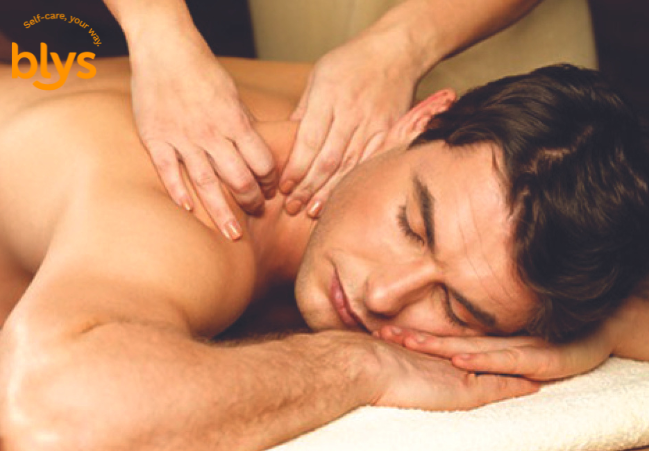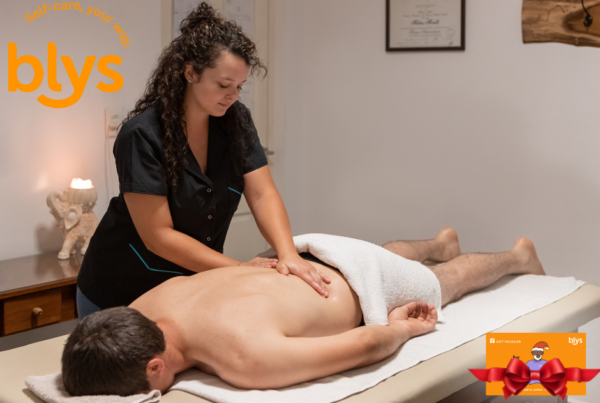
In today’s world, more people are taking health and recovery into their own hands. Whether it’s managing work-related tension, training soreness, or long-standing muscular pain, the demand for self-managed care is on the rise. Brits are increasingly turning to tools and techniques they can use from home seeking comfort, flexibility, and ongoing relief without needing to rely entirely on clinic-based appointments.
One approach gaining traction is deep tissue massage at home. While deep tissue work is often associated with therapists using strong, focused pressure to target deeper muscle layers, it’s also possible to apply simple methods at home that offer meaningful results. With the right techniques and a little guidance, you can relieve tight spots, improve mobility, and support recovery between sessions.
Of course, some issues need a more experienced hand and that’s where Blys steps in. As the UK’s leading mobile wellness platform, Blys connects you with fully qualified therapists who specialise in mobile deep tissue massage, delivered right to your door. It’s recovery on your terms, wherever you are.
In this guide, you’ll discover practical, easy-to-follow tips for self-massage for pain relief, how to create a calming space at home, and when to call in a professional to help you feel your best.
What Is Deep Tissue Massage and Why It Helps
Deep tissue massage is a therapeutic technique that works by applying slow, firm pressure to target the deeper layers of muscle and fascia—the connective tissue that surrounds and supports your muscles. This approach helps break down adhesions, release tight knots, and encourage blood flow to areas of chronic tension.
Unlike gentle relaxation massage, deep tissue massage is designed for more focused relief. It’s especially useful for people dealing with:
- Chronic muscle pain: especially in the back, neck, and shoulders
- Knots and trigger points: that limit range of motion
- Postural tightness: from desk work or long hours of sitting
- Injury recovery: such as sports strain or repetitive use
- Built-up stress tension: in deep muscle layers
According to Harvard Health, therapeutic massage can ease muscle tension, improve circulation, and promote better mobility, especially for people managing ongoing pain. While their article focuses on massage therapy broadly, many of these benefits apply directly to deep tissue massage when delivered by a trained therapist.
Some aspects of deep tissue work can also be practised at home through targeted self-massage techniques. But when pain persists or muscle tightness is more advanced, professional care is key.
That’s why Blys offers mobile deep tissue massage delivered straight to your door so you can get the care you need, wherever you are.
Can You Really Do Deep Tissue Massage at Home?
You can perform deep tissue massage techniques at home to a certain extent and for many people, it’s a helpful way to manage everyday muscle tension, stay on top of postural tightness, and support recovery between professional sessions. With the rise of wellness tools and resources, self-massage is more accessible than ever. However, it’s important to understand both its potential and its limitations.
What You Can Achieve with At-Home Techniques
When done correctly, deep tissue massage at home can:
- Relieve mild to moderate muscle tightness
- Support circulation and lymphatic flow
- Improve flexibility and joint mobility
- Ease tension caused by prolonged sitting or standing
- Complement regular stretching and movement routines
These benefits are especially noticeable when you incorporate massage into a consistent wellness routine. Simple techniques like using your body weight to apply pressure over a ball or foam roller can activate muscle release in areas like the glutes, calves, and upper back.
For a deeper look into how targeted massage can help manage long-term discomfort, read our guide on deep tissue massage for chronic pain relief.
Tools That Make Self-Massage More Effective
You don’t need fancy equipment to get started, but certain tools can enhance results:
- Massage balls: Ideal for glutes, shoulders, feet, and smaller muscle groups
- Foam rollers: Useful for larger areas like the thighs, hamstrings, and lower back
- Massage guns: Provide deeper pressure but should be used with caution
- Trigger point canes or sticks: Help reach difficult areas like the upper back or shoulder blades
Where to Be Cautious
Deep tissue work isn’t just about applying heavy pressure—it’s about technique, timing, and body awareness. Without professional training, it’s easy to go too deep or miss the actual source of the issue.
You should avoid at-home deep tissue massage if:
- You’re experiencing sharp, shooting, or unexplained pain
- You have a recent injury, swelling, or inflammation
- You feel worse after attempting pressure-based techniques
- You’re unsure about which muscle group is causing the discomfort
In these cases, it’s best to seek guidance from a professional therapist.
With Blys mobile deep tissue massage, you can get expert care at home from fully qualified therapists who tailor each session to your needs so you never have to guess what’s right for your body.
Self-Massage for Pain Relief: Techniques You Can Try Today
When muscles feel tight or sore, you don’t always have to wait for a clinic visit to find relief. With a few targeted self-massage techniques, you can release tension, encourage circulation, and support recovery right from your own home.
These simple approaches work best for mild discomfort, everyday fatigue, or in between professional sessions. All you need is a quiet space, a few tools, and some body awareness.
Trigger Point Release for Neck and Shoulders
Tension in the neck and shoulders is one of the most common complaints often caused by long hours at the desk, stress, or poor posture. To target these tight areas, sit upright and locate any tender spots by gently pressing along the upper traps or near the shoulder blades.
Once you find a knot, apply steady pressure with your fingers or a massage cane, holding it for 20 to 30 seconds until the area begins to soften. If you prefer a hands-free method, place a tennis ball between your back and a wall, lean into it, and adjust your position to find the trigger point.
Deep Glute Release for Lower Back Tension
Surprisingly, tight glutes can contribute to lower back pain. When these muscles stiffen, they can tug on the lower spine and cause discomfort. To ease the tension, sit on a firm surface and place a massage ball under one glute. Slowly roll your weight over the area until you locate a sore or tight point.
Hold the position for half a minute, allowing the pressure to release the muscle. Afterwards, do a glute stretch by crossing one leg over the other and gently leaning forward to enhance the release.
Calf and Foot Release for Sedentary Fatigue
Sitting for extended periods can lead to restricted circulation in the lower legs and feet. To refresh these areas, sit down and roll the sole of your foot over a massage ball, water bottle, or even a frozen can. Move slowly across the entire foot for one to two minutes, applying a comfortable amount of pressure.
For the calves, use your hands to press and knead from the ankle upward, or use a foam roller to gently glide across the muscle. This helps reduce tightness and restore a lighter, more energised feeling in your legs.
Forearm and Wrist Tension Relief
If you spend hours typing or using your hands for repetitive tasks, you might notice stiffness in your forearms or wrists. To release this tension, place your forearm on a flat surface with the palm facing up. Use your opposite thumb to apply firm pressure along the inner forearm, moving from wrist to elbow in slow strokes.
Repeat on the outer forearm. You can also roll a massage ball under your forearm for a deeper effect. Be gentle around the wrist joint and stop if any numbness or tingling occurs.
Upper Back and Spine-Friendly Release
The muscles around the upper spine can become tight and achy, especially if your posture slouches forward. For a simple at-home fix, lie on the floor with two tennis balls placed side by side just under your upper back on either side of the spine.
Relax your body weight onto the balls and breathe deeply. You can gently move up and down to massage the muscles along the spine but avoid placing direct pressure on the bones themselves. This method helps to ease built-up tension and restore better posture.
Want a personalised demo or deeper care? Book a Blys mobile therapist and enjoy expert treatment without leaving your home.
How to Set the Right Space for At-Home Massage
Creating a comfortable, calming environment is key to getting the most out of your deep tissue massage at home. Whether you’re doing self-massage or preparing for a professional session with a Blys therapist, your surroundings can either support or hinder the experience. The goal is to help your body relax, reduce distractions, and enhance the physical and mental benefits of massage.
To get started, you don’t need an entire spa setup. A quiet room, a few household items, and a bit of preparation go a long way. Here’s how to transform any room into your own home wellness space:
| Element | Why It Matters | Simple Setup Tips |
| Lighting | Dim lighting helps the nervous system wind down and signals the body to relax. | Use a lamp with a warm bulb, or natural light with curtains drawn to soften the glow. |
| Quiet Atmosphere | Reduces external distractions and allows deeper relaxation. | Turn off TVs and phones. Play calming music or nature sounds in the background. |
| Scent/Aromatherapy | Certain essential oils like lavender and eucalyptus can enhance the massage effect. | Use a diffuser or a few drops on a tissue placed nearby. |
| Heating Pad/Warmth | Heat helps soften muscle tissue and improve circulation before massage. | Apply a heat pack to tight areas 10–15 minutes before starting. |
| Clean Space | A tidy space encourages calm and prevents interruptions. | Clear clutter and prepare a towel or yoga mat if lying down. |
If you’ve booked a Blys mobile deep tissue massage, you won’t need to worry about equipment. Blys therapists bring everything needed from the massage table and fresh towels to oils and music so all you need to do is set the tone.
Prefer to stay in control of your environment? These easy adjustments can help turn any corner of your home into a private recovery zone, making each massage session more restorative and effective.
If you’re unsure whether deep tissue massage is the right choice for you, check out our comparison of deep tissue vs swedish massage to better understand their key differences and benefits.
When to Call in a Mobile Deep Tissue Therapist
While self-massage is useful for everyday tension and minor aches, there are times when your body needs more than at-home care. Deep tissue massage, when delivered by a qualified therapist, goes beyond surface-level relief it can help address the root cause of chronic issues, restore proper movement, and support longer-term recovery.
So how do you know when it’s time to call in a professional?
Signs You Should Book a Therapist
If you’re experiencing any of the following, it may be time to stop self-treating and seek expert support:
- Persistent or radiating pain: especially if it travels down the arms or legs, or worsens with activity
- Limited mobility: such as stiffness that restricts your ability to bend, turn, or move normally
- Post-surgery or injury recovery: where massage may be helpful but should be done under professional supervision and with medical clearance
- Recurring issues: like muscle knots or spasms that keep returning despite stretching and home techniques
- Tension linked to stress or burnout: where full-body relief and relaxation can help ease both physical and emotional symptoms
When you book a Blys mobile deep tissue massage, you’re getting more than just a treatment you’re receiving care from a vetted, fully qualified therapist who understands how to tailor pressure, pace, and technique to your body’s needs.
Book your in-home session with a trusted Blys therapist here and enjoy the benefits of professional massage without ever leaving the house.
Whether you’re managing ongoing pain or just want a deeper release than self-massage can provide, having an experienced therapist come to you can make all the difference.
Recovery Tips to Make Relief Last Longer
Getting relief from deep tissue massage whether done at home or by a professional—is just the start. What you do afterwards can significantly impact how long that relief lasts. Recovery doesn’t have to be complicated, but a few smart habits can help you feel better for longer and support your body’s healing process.
1. Stay hydrated
Deep tissue work increases circulation and encourages the release of waste products from muscle tissue. Drinking plenty of water after your massage helps flush out toxins and keeps your muscles supple. Aim for a full glass of water within 30 minutes after your session and continue sipping throughout the day.
2. Move gently
While you might feel like resting immediately, light movement such as walking, gentle stretching, or mobility drills can prevent stiffness and keep your muscles engaged. Avoid heavy workouts or strenuous activity right after massage let your body recover first.
3. Use heat or cold wisely
Applying a warm compress to tight areas can help soften muscles and improve blood flow, while a cold pack can reduce any inflammation or soreness after a more intense session. Choose based on how your body feels warmth for tension, cold for sharp discomfort.
4. Stretch and mobilise
Regular stretching or light mobility exercises between massages can improve flexibility and maintain the benefits of deep tissue work. Focus on areas that tend to tighten easily, like the hips, shoulders, and lower back. This helps prevent tension from building back up.
Want more guidance on how to support muscle recovery at home? Check out the Blys blog on deep tissue massage for muscle recovery for tips, expert insights, and wellness advice tailored to your routine.
Making massage part of a broader recovery plan ensures you’re not just feeling better—but staying better.
Real Care Deep Tissue With Blys
Self-massage is a powerful tool to have in your wellness toolkit. It gives you the flexibility to manage tension day to day, tune in to your body’s needs, and stay proactive about your recovery. But for deeper pain, recurring issues, or when you simply want to fully switch off and recharge nothing replaces the skill and experience of a professional therapist. The best results often come from combining both approaches.
A balanced routine might include self-massage a few times a week for maintenance, stretching or mobility work to support flexibility, and regular deep tissue sessions to address more stubborn tension or chronic patterns. It’s not about choosing one or the other it’s about finding what works for your body, lifestyle, and goals.
With Blys mobile deep tissue massage, expert care comes to you. Therapists are fully qualified, bring all the equipment, and customise the session to suit your needs so you can get the most out of every massage without leaving the house.
Feel better, move easier. Book your deep tissue massage at home with Blys today.





